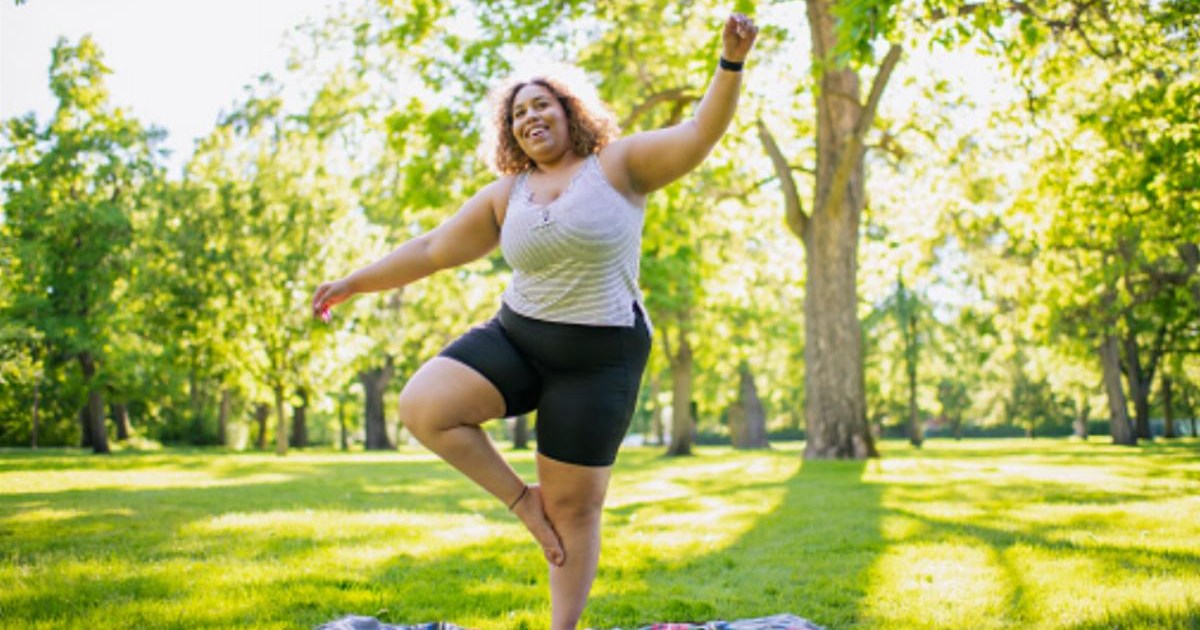
A quick minute(ish) activity can reveal a lot about your health.
We know our bodies change physically as we get age: from our skin and hair, to the ability to digest certain foods.
And now, recent research reveals the length of time you can stand on one leg also changes with age. In a new paper, a team of researchers suggest that strength and balance involved in the pose is among the first to go.
The researchers found that after the age of 65, there was a sharp drop off as older participants struggled to hold their stance for over two seconds.
In the study, which is published in the journal PLoS One, the authors wrote: ‘These findings suggest that the duration of unipedal stance [standing on one leg] can serve as a reliable and gender-independent measure of neuromuscular aging for both elderly male and female subjects.’

So, standing on one leg is a good way to measure how much balance you have. The researchers wrote that it is a ‘a valid measure of frailty, independence, and fall status and proves to be a useful tool in identifying patients with peripheral neuropathy.’
And luckily for us, the NHS has a guideline on how long you should be able to stand on one leg for – depending on your age of course.
Just last year, the NHS Suffolk and North East Essex Integrated Board asked: ‘How long can you stand on one leg like a flamingo?’

They added: ‘It might sound like an odd question, but your answer to the above question could tell you a lot about your general health and fitness’.
The rules are:
- Stand on one leg without any other support
- Keep your eyes open and your hands on your hips
- Time starts when your foot leaves the ground and stops when you put your foot back down (or when you take your hands off your hips)
Ages 18-39: 43 seconds

If you are aged between 18-39, you should be able to stand on one leg, like a flamingo, for 43 seconds.
Selina Lim, Divisional Director for Integrated Pathways at the NHS East Suffolk and North Essex NHS Foundation Trust (ESNEFT), said: ‘We know that people who struggle to balance for the expected amount of time are at a higher risk of developing ill-health as they age.
‘By taking part in the “flamingo challenge” people can quickly and easily assess for themselves whether they are at risk. If they are, there are lots of different activities they can engage in that can help improve their overall fitness.’
Ages 40-49: 40 seconds

If you are aged between 40 and 49, you should be able to stand on one leg for 40 seconds.
Doesn’t sound like a long time, but as you get older, the length of time you can stand on one leg decreases
Ages 50-59: 37 seconds

Those aged between 50 to 59, you should be able to stand on one leg for 37 seconds.
According to the British Journal of Sports Medicine, the inability to stand on one leg for 10 seconds in mid to later life is linked to a near doubling in the risk of death from any cause within the next 10 years.
Ages 60-69: 30 seconds

If you are aged between 60 to 69, you should be able to stand on one leg for 30 seconds.
Debbie Dyer, Clinical Lead for Ageing Well and Anticipatory Care at the North East Essex Alliance, said: ‘Moving our bodies more day-to-day brings immediate benefit, too. Exercise is brilliant for mental health and is a great way of meeting new people in your community.
‘The fitter and healthier you are, the better your mental wellbeing, and the longer you will retain your agility, strength, and balance into later life.’
Ages 70-79: 18 seconds. 80+: 5 seconds

Those aged between 70 to 79 should be able to stand on one leg for around 18-19 seconds. If you’re over 80, you should be able to stand on your leg for a little over 5 seconds.
The NHS recommends not to try and maintain the pose for longer than a minute though.
Do you have a story to share?
Get in touch by emailing MetroLifestyleTeam@Metro.co.uk.
MORE: Bridesmaid refused to attend wedding because she couldn’t bring her own food
MORE: Are these popular fitness and health beliefs fact or fiction? We ask the experts
MORE: Friends tell me I’m ‘too old’ for my favourite hobby – I’m not





